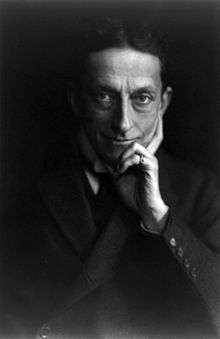Johnston Forbes-Robertson
| Sir Johnston Forbes-Robertson | |
|---|---|
 | |
| Born |
16 January 1853 London, England |
| Died |
6 November 1937 Bloms, The Droveway, St. Margaret's Bay, Dover, England |
| Occupation | actor |
| Years active | 1874-1913 |
| Spouse(s) | Gertrude Elliott |
| Children |
Maxine Miles; Jean Forbes-Robertson; Chloe Forbes-Robertson; Diana Forbes-Robertson |
Sir Johnston Forbes-Robertson (16 January 1853 – 6 November 1937[1]) was an English actor and theatre manager. He was considered the finest Hamlet of the Victorian era and one of the finest actors of his time, despite his dislike of the job and his lifelong belief that he was temperamentally unsuited to acting.[1]
Early life

Born in London, he was the eldest of the eleven children of John Forbes-Robertson, a theatre critic and journalist from Aberdeen, and his wife Frances. One of his sisters, Frances (1866–1956), and three of his brothers, Ian Forbes-Robertson (1859–1936), Norman Forbes-Robertson (1858–1932) and John Kelt (Eric Forbes-Robertson) (1865–1935), also became actors. He was the brother-in-law of famed actress Maxine Elliott, the uncle of Roy Harrod[2] the economist, and he was also the great-uncle of actress Meriel Forbes (granddaughter of his brother Norman), who married actor Sir Ralph Richardson.
He was educated at Charterhouse. Originally intending to become an artist, he trained for three years at the Royal Academy. He began a theatrical career, out of a desire to be self-supporting, when the dramatist William Gorman Wills, who had seen him in private theatricals. offered him a role in his play Mary Queen of Scots.
His many performances led him into, among other things, travel to the U.S., and work with Sir Henry Irving. He was hailed as one of the most individual and refined of English actors. He was a personal friend of the Duke of Sutherland and his family and often stayed with them at Trentham Hall; he is known to have recommended to them various writers and musicians in dire need of assistance.
Forbes-Robertson first came to prominence playing second leads to Henry Irving before making his mark as the greatest interpreter of Hamlet of the nineteenth century, according to many critics. One of his early successes was in W. S. Gilbert's Dan'l Druce, Blacksmith. In 1882, he starred with Lottie Venne and Marion Terry in G. W. Godfrey's comedy The Parvenu at the Court Theatre.[3] He was noted for his elocution, particularly by George Bernard Shaw who wrote the part of Caesar in Caesar and Cleopatra for him. Forbes-Robertson's other notable roles were Romeo, Othello, Leontes in The Winter's Tale, and the leading role in The Passing of the Third Floor Back; performed on Broadway 1908 (filmed in 1916, released 1918). He did not play Hamlet until he was 44 years old, but after his success in the part he continued playing it until 1916, including a surviving silent film (1913). Shaw considered him the greatest Hamlet he had ever seen.
He was also a talented painter who did a portrait of his mentor Samuel Phelps that currently hangs in the Garrick Club in London. Forbes-Robertson acted in plays with the gifted actress Mary Anderson in the 1880s. He became smitten with her, fell in love with her and asked her hand in marriage. She kindly turned him down though they remained friends. Later he and actress Beatrice Campbell enjoyed a brief affair during the time she starred with him in a series of Shakespearean plays in the mid-1890s.
Personal life

In 1900, at age 47, he married American-born actress Gertrude Elliott (1874–1950), sister of Maxine Elliott, with whom he had four daughters. Their first daughter was Maxine Forbes-Robertson known as 'Blossom',[4] who married the aircraft designer F.G. Miles and became a director and designer of the Miles Aircraft company. She previously married Inigo Brassey Freeman-Thomas, 2nd Marquess of Willingdon in 1924 and divorced in 1932. Their second daughter Jean Forbes-Robertson became an accomplished actress. Their third daughter was Chloe Forbes-Robertson (1909–1947), an artist. Diana Forbes-Robertson (1914–1988), their fourth daughter, was a writer who later wrote a biography of her aunt Maxine Elliott. Through his daughter Jean he is the grandfather of actress Joanna Van Gyseghem. Johnston Forbes-Robertson was knighted in 1913 at the age of 60.
In the last years of his life he produced plays by George Bernard Shaw and Jerome K. Jerome. His literary works include: The Life and Life-Work of Samuel Phelps (actor and theatre manager) as well as his own autobiography Johnston Forbes-Robertson: A Player Under Three Reigns (1925).
A statue of Forbes-Robertson by Brenda Putnam (1932) can be found at the Folger Shakespeare Library in Washington D.C..
The Great Painters of Christendom From Cimabue to Wilkie was written by his father, John Forbes-Robertson. see: The New York Times
In 1937 (age 84), he died on 6 November in St. Margaret's Bay, near Dover, England, UK.[1]
Partial filmography
- Hamlet (1913)
- Masks and Faces (1917)
- The Passing of the Third Floor Back (1918)
References
- 1 2 3 Sir Johnston Forbes Robertson, Beauty And Grace In Acting, Obituaries, The Times, 8 November 1937.
- ↑ P. M. Oppenheimer, ‘Harrod, Sir (Henry) Roy Forbes (1900–1978)’, rev. Oxford Dictionary of National Biography, Oxford University Press, 2004; online edn, May 2010 accessed 8 Oct 2011
- ↑ Culme, John. Footlight Notes No. 389 at Footlightnotes.tripod.com, accessed 18 November 2009
- ↑ ”Biography of Blossom Miles.””Museum of Berkshire Aviation” Retrieved:25 April2012.
Further reading
- Berry, Ralph. "Robertson, Sir Johnston Forbes (1853–1937)", Oxford Dictionary of National Biography, Oxford University Press, 2004. Accessed 17 Jan 2008]
External links
| Wikimedia Commons has media related to Johnston Forbes-Robertson. |
- Johnston Forbes-Robertson at IMDb.com
- Johnston Forbes-Robertson photo gallery NYP Library.
|